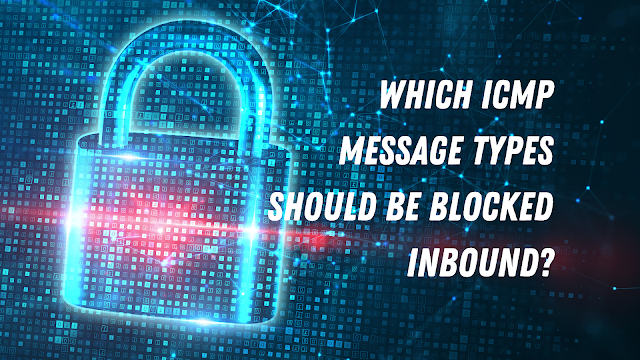🛡️ Which ICMP Message Types Should Be Blocked Inbound?
Introduction
The Internet Control Message Protocol (ICMP) is a fundamental component of the Internet Protocol Suite, primarily used for error messages and operational information queries. While ICMP plays a crucial role in network diagnostics and management, certain ICMP message types can be exploited by malicious actors to compromise network security. This comprehensive guide delves into which ICMP message types should be blocked inbound to enhance security without disrupting essential network functionalities.
Understanding ICMP
ICMP operates at the network layer and is used by network devices, like routers, to send error messages and operational information indicating success or failure when communicating with another IP address. Common tools like ping and traceroute utilize ICMP messages to function.
ICMP Message Structure
An ICMP message consists of the following components:
- Type (8 bits): Indicates the type of the message.
- Code (8 bits): Provides further information about the message type.
- Checksum (16 bits): Used for error-checking the header and data.
- Rest of Header: Varies based on the message type and code.
Common ICMP Message Types
| Type | Code | Description |
|---|---|---|
| 0 | 0 | Echo Reply |
| 3 | 0-15 | Destination Unreachable |
| 4 | 0 | Source Quench (Deprecated) |
| 5 | 0-3 | Redirect |
| 8 | 0 | Echo Request |
| 11 | 0-1 | Time Exceeded |
| 13 | 0 | Timestamp Request |
| 14 | 0 | Timestamp Reply |
Security Risks Associated with ICMP
While ICMP is essential for network operations, it can be exploited in various ways:
- Reconnaissance: Attackers use ICMP Echo Requests to map networks and identify active hosts.
- Denial of Service (DoS) Attacks: ICMP Flood and Smurf attacks overwhelm systems with ICMP traffic.
- ICMP Tunneling: Encapsulating data within ICMP packets to bypass firewalls and exfiltrate data.
- Redirect Attacks: Malicious ICMP Redirect messages can alter routing tables, redirecting traffic through attacker-controlled devices.
ICMP Message Types to Block Inbound
1. Echo Request (Type 8)
Used by the ping utility to check host availability. Blocking inbound Echo Requests can prevent network mapping and reconnaissance by attackers.
2. Redirect (Type 5)
Suggests alternative routes for packets. Malicious Redirect messages can reroute traffic through compromised paths. Blocking these messages helps maintain routing integrity.
3. Source Quench (Type 4)
Intended to signal congestion and request rate reduction. This message type is deprecated and can be safely blocked.
4. Timestamp Request and Reply (Types 13 and 14)
Used for time synchronization. Rarely used in modern networks and can be exploited for network mapping. Blocking these messages is advisable.
ICMP Message Types to Allow Inbound
1. Destination Unreachable (Type 3)
Indicates that a packet could not reach its destination. Essential for Path MTU Discovery and should be allowed.
2. Time Exceeded (Type 11)
Sent when a packet's Time to Live (TTL) expires. Necessary for traceroute and diagnosing routing loops.
Implementing ICMP Controls with iptables
On Linux systems, iptables can be used to control ICMP traffic:
# Block inbound Echo Requests
iptables -A INPUT -p icmp --icmp-type 8 -j DROP
# Block inbound Redirect messages
iptables -A INPUT -p icmp --icmp-type 5 -j DROP
# Block inbound Source Quench messages
iptables -A INPUT -p icmp --icmp-type 4 -j DROP
# Block inbound Timestamp Requests and Replies
iptables -A INPUT -p icmp --icmp-type 13 -j DROP
iptables -A INPUT -p icmp --icmp-type 14 -j DROP
# Allow inbound Destination Unreachable messages
iptables -A INPUT -p icmp --icmp-type 3 -j ACCEPT
# Allow inbound Time Exceeded messages
iptables -A INPUT -p icmp --icmp-type 11 -j ACCEPTRate Limiting ICMP Traffic
Instead of outright blocking, rate limiting ICMP messages can mitigate abuse while preserving functionality:
# Limit Echo Requests to 1 per second with a burst of 5
iptables -A INPUT -p icmp --icmp-type 8 -m limit --limit 1/s --limit-burst 5 -j ACCEPTReal-World Example: Smurf Attack
A Smurf attack involves sending ICMP Echo Requests to broadcast addresses with a spoofed source IP, causing all hosts to reply to the victim, overwhelming their network.
Mitigation Strategies:
- Configure routers to not respond to ICMP requests sent to broadcast addresses.
- Implement ingress filtering to prevent IP spoofing.
- Block or rate-limit ICMP Echo Requests.
Summary of ICMP Inbound Filtering Recommendations
| ICMP Type | Description | Inbound Action |
|---|---|---|
| 0 | Echo Reply | Allow |
| 3 | Destination Unreachable | Allow |
| 4 | < ::contentReference[oaicite:0]{index=0}





